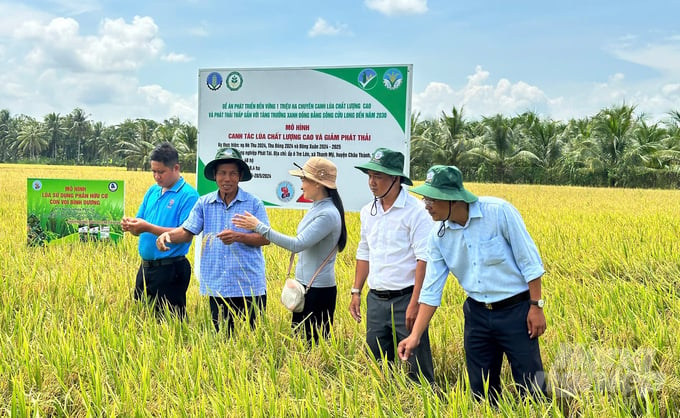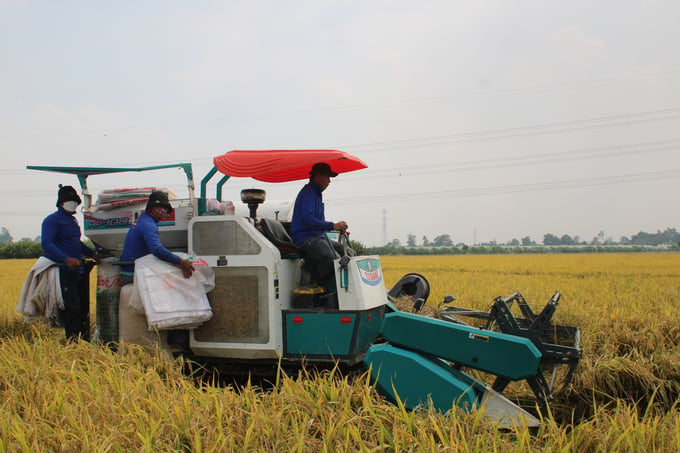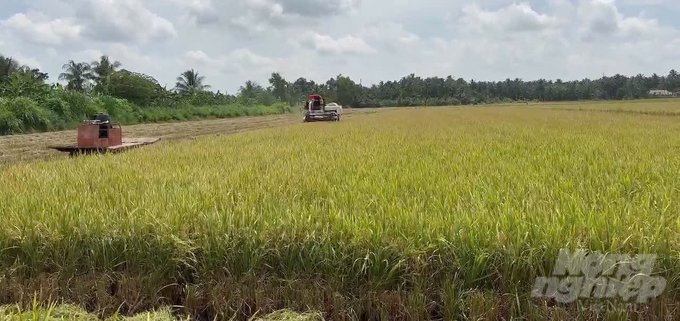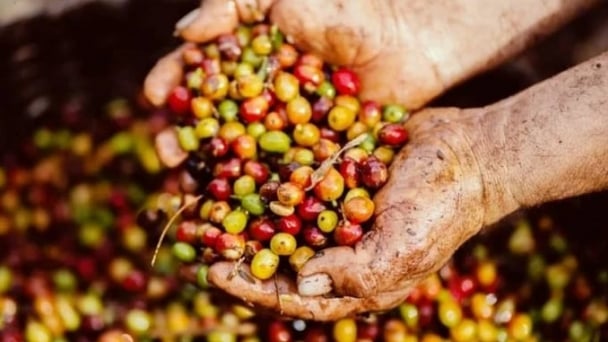June 18, 2025 | 01:50 GMT +7
June 18, 2025 | 01:50 GMT +7
Hotline: 0913.378.918
June 18, 2025 | 01:50 GMT +7
Hotline: 0913.378.918

Members of Phat Tai Cooperative discuss with agricultural extension officers and businesses supporting the model about alternate flooding and drying farming techniques. Photo: Ho Thao.
In Tra Vinh, most rice producers are delighted with the favorable rice prices during the summer-autumn crop season. Their pleasure is heightened as they observe the initial high-quality rice fields entering the harvest season.
The Phat Tai Agricultural Cooperative members in O Tre Lon hamlet, Thanh My commune, Chau Thanh district, have gathered in the fields since the early morning, anxiously following each pass of the harvesting machines to observe the results of their collective efforts. This is one of two pilot models that Tra Vinh province has chosen to participate in the 1 Million Hectares of High-Quality, Low-Emission Rice Project. The project encompasses 48 hectares of land that are cultivated by 48 cooperative members.
By participating in the model, members were provided with training and the opportunity to apply cultivation techniques, such as row sowing, sparse sowing in conjunction with deep fertilizer application, reducing the use of seeds, fertilizers, and pesticides, alternating wet and dry water management, removing 100% of straw from the field, and using exclusively certified seeds. In actuality, the rice plants were disease-free, robust, and resistant to lodging.
Mr. Tran Van Chung, Director of the Phat Tai Agricultural Cooperative, expressed his satisfaction with the results, which surpassed expectations with a produce of 6.3 tons/ha, which is 0.3 tons/ha higher than other fields. The average profit was 30.3 million VND/ha, a 5.6 million VND increase from traditional cultivation, and the total investment cost was 22.3 million VND/ha, which was nearly 3.2 million VND lower. The cooperative has received numerous applications from prospective members for the upcoming year.
"At present, traders have acquired all of the rice at a price of 8,500 VND/kg, resulting in each member earning nearly 4 million VND per 1,000m². This is a 1 million VND/1,000m² increase from the previous year, and as a result, everyone is exceedingly pleased. I intend to increase the size of the operation by an additional 500 hectares in the upcoming season to facilitate the participation, collaboration, and profitability of a greater number of individuals", Mr. Chung stated.
Initially, cooperative members were unfamiliar with the standardized methods, such as the synchronization of water in and out of the fields, according to the members. They were also apprehensive about the yield when they reduced the quantity of seed; however, after one season, everything became simpler. This model not only increased profits but also assisted farmers in transitioning from conventional agricultural perspectives.
Previously, Mr. Quach Van Ut in O Tre Lon hamlet, Thanh My commune, revealed, "I used to sow 17kg of seeds per công. However, when I participated in the model, the amount was reduced to 8kg. Initially, I was concerned that the yield would not be achieved; however, the seedlings grew in straight rows and grew evenly, which made it simpler to spray pesticides and reduced rodent damage. The rice plants continued to thrive, blossom uniformly, produce fewer unfilled kernels, and yield more, despite a substantial decrease in fertilizer costs, from nearly a bag per 1,000m² to a mere 3-4kg. Not to mention, the rice plants became more resilient, even in the face of torrential rain and strong winds, as a result of the alternating wet and dry water management three times per season."
According to Mr. Ut, farmers receive numerous advantages by participating in the project, including training in novel cultivation techniques and assistance with seedlings and fertilizers. Most importantly, the rice is branded with a high level of quality.

Farmers in Tra Vinh province are excited to harvest rice in the model participating in the Project of 1 million hectares of high-quality, low-emission rice. Photo: Ho Thao.
The preliminary results of the two pilot models participating in the Project exceeded expectations, according to Mr. Le Van Dong, Deputy Director of the Department of Agriculture and Rural Development of Tra Vinh province. The quantity of seeds was decreased by 60%, from 20kg to 8kg/ha, and the requirement for fertilizer was reduced by 20-30%, necessitating only two applications per crop. At Phat Tai Agricultural Cooperative, farmers' profits increased by 5.6 million VND/ha, while at Phước Hảo Agricultural Cooperative, they increased by 7.6 million VND/ha. Furthermore, the quality of rice was enhanced as a result of a 20-30% decrease in environmental emissions.
According to Deputy Director Le Van Dong, the Ministry of Agriculture and Rural Development, its affiliated units, agricultural extension forces, and enterprises worked in close collaboration with producers from the project's inception to achieve these results.
The Department collaborated with Saigon Kim Hong Trading and Service Co., Ltd. to conduct training sessions for the two cooperatives on cluster sowing and cluster sowing combined with thorough fertilizer application. Additionally, they collaborated with the National Agricultural Extension Center to provide production process training to 100 participants.
To finalize the detailed production area maps for each household participating in the model, the Department collaborated with the Institute of Agricultural Environment (Vietnam Academy of Agricultural Sciences) and selected 10 sites for monitoring and evaluation using the MRV (Measurement, Reporting, and Verification) method.
Furthermore, the Department of Agriculture and Rural Development partnered with Binh Duong Water - Environment Corporation to supply and facilitate the use of 49 tons of organic fertilizer for the two cooperatives. Additional enterprises are also in the process of preparing to assist in the model's expansion throughout the province.
Mr. Le Van Dong encouraged the businesses that have pledged to assist farmers who are involved in the Project to adhere rigorously to the procedures established by the Department of Crop Production in order to accomplish the established objectives. To guarantee regulatory conformance, the Plant Protection Department will closely supervise pesticide standards and monitor fertilizer usage. Tra Vinh is also advocating for mechanization, particularly in the context of soil preparation, in order to reduce hazards and improve production efficiency.

Tra Vinh will expand to the entire province, each district will have a high-quality, low-emission rice model. Photo: Ho Thao.
The Deputy Director observed that Tra Vinh intends to extend the high-quality, low-emission rice cultivation model to other districts. In particular, the province will have eight models, with two of them being supported by the Ministry of Agriculture and Rural Development and six being implemented by the districts. The autumn-winter crop is anticipated to span 400 hectares this year, with a produce of 6 tons per hectare, resulting in a total of 2,400 tons. Each model will cover an average area of 50 hectares.
Translated by Linh Linh
![Turning wind and rain into action: [7] Early disaster warnings help marine farmers minimize losses](https://t.ex-cdn.com/nongnghiepmoitruong.vn/608w/files/news/2025/06/17/z6704423696987_15fd32ffc26d590d204d520c9dac6786-nongnghiep-142942.jpg)
(VAN) In recent years, thanks to early disaster warnings and forecasting, marine farmers in Khanh Hoa province have been able to reduce risks and losses, thereby improving production efficiency.
![Turning wind and rain into action: [6] ‘Four on-the-spot’ disaster management software](https://t.ex-cdn.com/nongnghiepmoitruong.vn/608w/files/news/2025/06/17/e5a48259d6a262fc3bb3-nongnghiep-183800.jpg)
(VAN) By simply activating the scenario on the disaster management software, the relevant authorities immediately know how many households need to be evacuated, where to evacuate them to, and by what means of transportation…
![Turning wind and rain into action: [5] Hue applies modern technology in disaster forecasting](https://t.ex-cdn.com/nongnghiepmoitruong.vn/608w/files/news/2025/06/17/z6704423696987_15fd32ffc26d590d204d520c9dac6786-nongnghiep-093938.jpg)
(VAN) In Hue city, modern technology has recently been applied in meteorological and hydrological forecasting and warning, helping to reduce the damage caused by natural disasters.

(VAN) A cutting-edge farming technique being implemented on an experimental ranch in Arizona's Sonoran Desert has already saved a billion gallons of water over five years, according to Civil Eats.

(VAN) Poultry and pig production and the environment can be boosted through enhanced water technology, according to new research.

(VAN) Coffee prices on June 16, 2025 are unchanged. In Vietnam, local trading prices are holding steady, ranging around VND 112,000 – VND 112,500/kg.
![Turning wind and rain into action: [4] Bringing climate bulletins to remote and isolated areas](https://t.ex-cdn.com/nongnghiepmoitruong.vn/608w/files/linhnhp/2025/06/14/1152-z6704423696987_15fd32ffc26d590d204d520c9dac6786-nongnghiep-151141.jpg)
(VAN) The Vietnam Agriculture and Nature Newspaper interviewed Mr. Vu Thai Truong, Acting Head of Climate Change and Environment at UNDP Vietnam, to gain deeper insight into how climate bulletins are delivered to farmers.